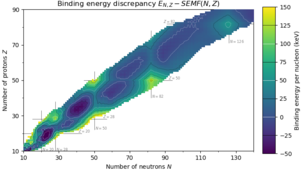
Back Magiese getal Afrikaans عدد سحري Arabic জাদু সংখ্যা (পদার্থবিজ্ঞান) Bengali/Bangla Núclid màgic Catalan Magické číslo (fyzika) Czech Magische Zahl (Physik) German Magia nombro (fiziko) Esperanto Número mágico (física) Spanish عدد جادویی (فیزیک) Persian Maagiset luvut Finnish

In nuclear physics, a magic number is a number of nucleons (either protons or neutrons, separately) such that they are arranged into complete shells within the atomic nucleus. As a result, atomic nuclei with a "magic" number of protons or neutrons are much more stable than other nuclei. The seven most widely recognized magic numbers as of 2019 are 2, 8, 20, 28, 50, 82, and 126 (sequence A018226 in the OEIS).
For protons, this corresponds to the elements helium, oxygen, calcium, nickel, tin, lead, and the hypothetical unbihexium, although 126 is so far only known to be a magic number for neutrons. Atomic nuclei consisting of such a magic number of nucleons have a higher average binding energy per nucleon than one would expect based upon predictions such as the semi-empirical mass formula and are hence more stable against nuclear decay.
The unusual stability of isotopes having magic numbers means that transuranium elements could theoretically be created with extremely large nuclei and yet not be subject to the extremely rapid radioactive decay normally associated with high atomic numbers. Large isotopes with magic numbers of nucleons are said to exist in an island of stability. Unlike the magic numbers 2–126, which are realized in spherical nuclei, theoretical calculations predict that nuclei in the island of stability are deformed.[1][2][3]

Before this was realized, higher magic numbers, such as 184, 258, 350, and 462 (sequence A033547 in the OEIS), were predicted based on simple calculations that assumed spherical shapes: these are generated by the formula (see Binomial coefficient). It is now believed that the sequence of spherical magic numbers cannot be extended in this way. Further predicted magic numbers are 114, 122, 124, and 164 for protons as well as 184, 196, 236, and 318 for neutrons.[1][4][5] However, more modern calculations predict 228 and 308 for neutrons, along with 184 and 196.[6]
- ^ a b Kratz, J. V. (5 September 2011). The Impact of Superheavy Elements on the Chemical and Physical Sciences (PDF). 4th International Conference on the Chemistry and Physics of the Transactinide Elements. Retrieved 27 August 2013.
- ^ "Nuclear scientists eye future landfall on a second 'island of stability'".
- ^ Grumann, Jens; Mosel, Ulrich; Fink, Bernd; Greiner, Walter (1969). "Investigation of the stability of superheavy nuclei aroundZ=114 andZ=164". Zeitschrift für Physik. 228 (5): 371–386. Bibcode:1969ZPhy..228..371G. doi:10.1007/BF01406719. S2CID 120251297.
- ^ "Nuclear scientists eye future landfall on a second 'island of stability'".
- ^ Grumann, Jens; Mosel, Ulrich; Fink, Bernd; Greiner, Walter (1969). "Investigation of the stability of superheavy nuclei aroundZ=114 andZ=164". Zeitschrift für Physik. 228 (5): 371–386. Bibcode:1969ZPhy..228..371G. doi:10.1007/BF01406719. S2CID 120251297.
- ^ Koura, H. (2011). Decay modes and a limit of existence of nuclei in the superheavy mass region (PDF). 4th International Conference on the Chemistry and Physics of the Transactinide Elements. Retrieved 18 November 2018.
© MMXXIII Rich X Search. We shall prevail. All rights reserved. Rich X Search
